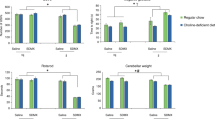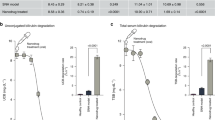Abstract
Background
Premature infants may suffer from high levels of bilirubin that could lead to neurotoxicity. Bilirubin has been shown to decrease L1-mediated ERK1/2 signaling, L1 phosphorylation, and L1 tyrosine 1176 dephosphorylation. Furthermore, bilirubin redistributes L1 into lipid rafts (LR) and decreases L1-mediated neurite outgrowth. We demonstrate that choline supplementation improves L1 function and signaling in the presence of bilirubin.
Methods
Cerebellar granule neurons (CGN) were cultured with and without supplemental choline, and the effects on L1 signaling and function were measured in the presence of bilirubin. L1 activation of ERK1/2, L1 phosphorylation and dephosphorylation were measured. L1 distribution in LR was quantified and neurite outgrowth of CGN was determined.
Results
Forty µM choline significantly reduced the effect of bilirubin on L1 activation of ERK1/2 by 220% (p = 0.04), and increased L1 triggered changes in tyrosine phosphorylation /dephosphorylation of L1 by 34% (p = 0.026) and 35% (p = 0.02) respectively. Choline ameliorated the redistribution of L1 in lipid rafts by 38% (p = 0.02) and increased L1-mediated mean neurite length by 11% (p = 0.04).
Conclusion
Choline pretreatment of CGN significantly reduced the disruption of L1 function by bilirubin. The supplementation of pregnant women and preterm infants with choline may increase infant resilience to the effects of bilirubin.
Impact
-
This article establishes choline as an intervention for the neurotoxic effects of bilirubin on lipid rafts.
-
This article provides clear evidence toward establishing one intervention for bilirubin neurotoxicity, where little is understood.
-
This article paves the way for future investigation into the mechanism of the ameliorative effect of choline on bilirubin neurotoxicity.
This is a preview of subscription content, access via your institution
Access options
Subscribe to this journal
Receive 14 print issues and online access
$259.00 per year
only $18.50 per issue
Buy this article
- Purchase on Springer Link
- Instant access to full article PDF
Prices may be subject to local taxes which are calculated during checkout






Similar content being viewed by others
References
Osterman, M.J.K., Hamilton, B.E., Martin, J.A., Driscoll, A.K., Valenzuela, C.P. National vital statistics reports, Vol. 72, Number 1 January 31, 2023. https://www.cdc.gov/nchs/products/index.htm (2021).
Xoinis, K., Weirather, Y., Mavoori, H., Shaha, S. H. & Iwamoto, L. M. Extremely low birth weight infants are at high risk for auditory neuropathy. J. Perinatol. 27, 718–723 (2007).
Okumura, A. et al. Kernicterus in preterm infants. Pediatrics 123, e1052–e1058 (2009).
Arnold, C., Pedroza, C. & Tyson, J. E. Phototherapy in ELBW newborns: does it work? Is it safe? The evidence from randomized clinical trials. Semin. Perinatol. 38, 452–464 (2014).
Morris, B. H. et al. Aggressive vs. conservative phototherapy for infants with extremely low birth weight. N. Engl. J. Med. 359, 1885–1896 (2008).
Sedlak, T. W. & Snyder, S. H. Bilirubin benefits: cellular protection by a biliverdin reductase antioxidant cycle. Pediatrics 113, 1776–1782 (2004).
Amin, S. B., Smith, T. & Wang, H. Is neonatal jaundice associated with autism spectrum disorders: a systematic review. J. Autism Dev. Disord. 41, 1455–1463 (2011).
Ahlfors, C. E. Predicting bilirubin neurotoxicity in jaundiced newborns. Curr. Opin. Pediatr. 22, 129–133 (2010).
Ostrow, J. D., Pascolo, L. & Tiribelli, C. Reassessment of the unbound concentrations of unconjugated bilirubin in relation to neurotoxicity in vitro. Pediatr. Res. 54, 98–104 (2003).
van der Schoor, L. W. E. et al. Unconjugated free bilirubin in preterm infants. Early Hum. Dev. 106–107, 25–32 (2017).
Kitchen S. T., et al. Bilirubin inhibits lipid raft dependent functions of L1 cell adhesion molecule in rat pup cerebellar granule neurons. Pediatr. Res. https://doi.org/10.1038/s41390-020-01156-0 (2020).
Ostrow, J. D., Pascolo, L., Brites, D. & Tiribelli, C. Molecular basis of bilirubin-induced neurotoxicity. Trends Mol. Med. 10, 65–70 (2004).
Rodrigues, C. M. P., Solá, S., Brito, M. A., Brites, D. & Moura, J. J. G. Bilirubin directly disrupts membrane lipid polarity and fluidity, protein order, and redox status in rat mitochondria. J. Hepatol. 36, 335–341 (2002).
Simons, K. & Gerl, M. J. Revitalizing membrane rafts: new tools and insights. Nat. Rev. Mol. Cell Biol. 11, 688–699 (2010).
Patel, H. H., Murray, F. & Insel, P. A. Caveolae as organizers of pharmacologically relevant signal transduction molecules. Annu. Rev. Pharm. Toxicol. 48, 359–391 (2008).
Epshtein, Y. et al. Identification of a C-terminus domain critical for the sensitivity of Kir2.1 to cholesterol. Proc. Natl. Acad. Sci. USA 106, 8055–8060 (2009).
Fantini, J. & Barrantes, F. J. Sphingolipid/cholesterol regulation of neurotransmitter receptor conformation and function. Biochim. Biophys. Acta 1788, 2345–2361 (2009).
Owen, D. M., Magenau, A., Williamson, D. & Gaus, K. The lipid raft hypothesis revisited–new insights on raft composition and function from super-resolution fluorescence microscopy. Bioessays 34, 739–747 (2012).
Korade, Z. & Kenworthy, A. K. Lipid rafts, cholesterol, and the brain. Neuropharmacology 55, 1265–1273 (2008).
Pike, L. J. The challenge of lipid rafts. J. Lipid Res. 50, S323–S328 (2009).
Tang, N. et al. Ethanol inhibits L1 cell adhesion molecule activation of mitogen-activated protein kinases. J. Neurochem. 96, 1480–1490 (2006).
Nakai, Y. & Kamiguchi, H. Migration of nerve growth cones requires detergent-resistant membranes in a spatially defined and substrate-dependent manner. J. Cell Biol. 159, 1097–1108 (2002).
Blusztajn, J. K. Choline, a vital amine. Science 281, 794–795 (1998). (1979).
Dietary reference intakes for Thiamin, Riboflavin, Niacin, Vitamin B6, Folate, Vitamin B12, Pantothenic Acid, Biotin, and Choline (National Academies Press, 1998) https://doi.org/10.17226/6015.
Zeisel, S. H. Choline, other methyl-donors and epigenetics. Nutrients. 9 https://doi.org/10.3390/nu9050445 (2017).
Signore, C., Ueland, M., Troendle, J., Mills, J. L. Choline concentrations in human maternal and cord blood and intelligence at 5 y of age 1-3. https://academic.oup.com/ajcn/article/87/4/896/4633379 (2008).
Tang, N. et al. Choline partially prevents the impact of ethanol on the lipid raft dependent functions of l1 cell adhesion molecule. Alcohol Clin. Exp. Res. 38, 2722–2730 (2014).
Davis, N. L., Tang, N., He, M., Lee, D. & Bearer, C. F. Choline ameliorates ethanol induced alterations in tyrosine phosphorylation and distribution in detergent-resistant membrane microdomains of L1 cell adhesion molecule in vivo. Birth Defects Res. 112, 480–489 (2020).
Bearer, C. F., Wellmann, K. A. A., Tang, N., He, M. & Mooney, S. M. M. Choline ameliorates deficits in balance caused by acute neonatal ethanol exposure. Cerebellum 14, 413–420 (2015).
Thomas, J. D., Garrison, M. & O’Neill, T. M. Perinatal choline supplementation attenuates behavioral alterations associated with neonatal alcohol exposure in rats. Neurotoxicol. Teratol. 26, 35–45 (2004).
Thomas, J. D. & Tran, T. D. Choline supplementation mitigates trace, but not delay, eyeblink conditioning deficits in rats exposed to alcohol during development. Hippocampus 22, 619–630 (2012).
Waddell J., Rickman N. C., He M., Tang N., Bearer C. F. Choline supplementation prevents the effects of bilirubin on cerebellar-mediated behavior in choline-restricted Gunn rat pups. Pediatr. Res. https://doi.org/10.1038/s41390-020-01187-7 (2020).
Bearer, C. F., Swick, A. R. R., O’Riordan, M. A. A. & Cheng, G. Ethanol inhibits L1-mediated neurite outgrowth in postnatal rat cerebellar granule cells. J. Biol. Chem. 274, 13264–13270 (1999).
Schmid, R. S., Pruitt, W. M. & Maness, P. F. A MAP kinase-signaling pathway mediates neurite outgrowth on L1 and requires Src-dependent endocytosis. J. Neurosci. 20, 4177–4188 (2000).
Tang, N. et al. Ethanol causes the redistribution of L1 cell adhesion molecule in lipid rafts. J. Neurochem. 119, 859–867 (2011).
Milstone, A. M. M. et al. Chlorhexidine inhibits L1 cell adhesion molecule-mediated neurite outgrowth in vitro. Pediatr. Res. 75, 8–13 (2014).
Gazzin, S., Vitek, L., Watchko, J., Shapiro, S. M. & Tiribelli, C. A novel perspective on the biology of bilirubin in health and disease. Trends Mol. Med. 22, 758–768 (2016).
Dudnik, L. B., Tsyupko, A. N., Khrenov, A. V. & Alessenko, A. V. Effect of bilirubin on lipid peroxidation, sphingomyelinase activity, and apoptosis induced by sphingosine and UV irradiation. Biochemistry 66, 1019–1027 (2001).
Vítek, L. & Tiribelli, C. Bilirubin: the yellow hormone? J. Hepatol. 75, 1485–1490 (2021).
Rodrigues, C. M. P. et al. Perturbation of membrane dynamics in nerve cells as an early event during bilirubin-induced apoptosis. J. Lipid Res. 43, 885–894 (2002).
Gallego-Ortega, D. et al. Differential role of human choline kinase alpha and beta enzymes in lipid metabolism: implications in cancer onset and treatment. PLoS One 4, e7819 (2009).
Zeisel, S. H. Nutritional genomics: defining the dietary requirement and effects of choline. J. Nutr. 141, 531–534 (2011).
Zhu, X. & Zeisel, S. H. Gene expression profiling in phosphatidylethanolamine N-methyltransferase knockout mice. Brain Res. Mol. Brain Res. 134, 239–255 (2005).
Otero, N. K., Thomas, J. D., Saski, C. A., Xia, X. & Kelly, S. J. Choline supplementation and DNA methylation in the hippocampus and prefrontal cortex of rats exposed to alcohol during development. Alcohol Clin. Exp. Res. 36, 1701–1709 (2012).
Zhang, L., Liu, W., Tanswell, A. K. & Luo, X. The effects of bilirubin on evoked potentials and long-term potentiation in rat hippocampus in vivo. Pediatr. Res. 53, 939–944 (2003).
Shapiro, S. M. Definition of the clinical spectrum of kernicterus and bilirubin-induced neurologic dysfunction (BIND). J. Perinatol. 25, 54–59 (2005).
Jensen, H. H., Matres-Marquez, S. P., Carriquiry, A., Schalinske, K. L. Choline in the diets of the US population: NHANES, 2003–2004. FASEB J. 21, LB46-LB46 (2007).
Meck, W. H. & Williams, C. L. Characterization of the facilitative effects of perinatal choline supplementation on timing and temporal memory. Neuroreport 8, 2831–2835 (1997).
Bahnfleth, C. L., Strupp, B. J., Caudill, M. A., Canfield, R. L. Prenatal choline supplementation improves child sustained attention: a 7-year follow-up of a randomized controlled feeding trial. FASEB J. 36, https://doi.org/10.1096/FJ.202101217R (2022).
Bell, C. C. & Aujla, J. Prenatal vitamins deficient in recommended choline intake for pregnant women. J. Fam. Med. Dis. Prev. 2, 48 (2016).
Acknowledgements
This work was supported by NIH R21HD085061, NIH R21HD105071, Mary Gray Cobey Endowment and Munro Funds. The datasets generated and analyzed during the current study are available from the corresponding author on reasonable request. This material is original and has not been previously published nor has it been submitted for publication elsewhere while under consideration.
Author information
Authors and Affiliations
Contributions
M.J. substantially contributed to the acquisition and analysis of data in this article as well as drafting and revising of the article. S.T.K. substantially contributed to the analysis and interpretation of data, and drafting and revising of this article. S.V. substantially contributed to the analysis and interpretation of data, and drafting and revising of this article. N.T. substantially contributed to the design of this study and the acquisition and analysis of data in this article. M.H. substantially contributed to the design of this study and the acquisition and analysis of data in this article. C.F.B. substantially contributed to the conception and design of this study and has final approval of the version to be published. This study was funded by R21HD085061 and R21HD105071, Rockville, MD (CB).
Corresponding author
Ethics declarations
Competing interests
The authors declare no competing interests.
Additional information
Publisher’s note Springer Nature remains neutral with regard to jurisdictional claims in published maps and institutional affiliations.
Rights and permissions
Springer Nature or its licensor (e.g. a society or other partner) holds exclusive rights to this article under a publishing agreement with the author(s) or other rightsholder(s); author self-archiving of the accepted manuscript version of this article is solely governed by the terms of such publishing agreement and applicable law.
About this article
Cite this article
Janampalli, M., Kitchen, S.T., Vatolin, S. et al. Choline supplementation mitigates effects of bilirubin in cerebellar granule neurons in vitro. Pediatr Res (2024). https://doi.org/10.1038/s41390-023-02968-6
Received:
Revised:
Accepted:
Published:
DOI: https://doi.org/10.1038/s41390-023-02968-6
This article is cited by
-
An egg a day keeps kernicterus away
Pediatric Research (2024)



